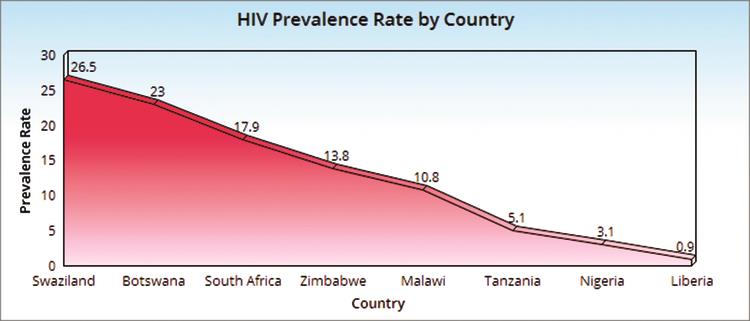
The Sunday Mail

Shamiso Yikoniko
Health Reporter
Zimbabwe’s HIV prevalence rate declined from 15, 7 percent in 2011 to 13, 8 in 2015 on the back of various Government strategies, the latest Global Aids Progress Report has revealed.
The strategies include early adoption and implementation of 2013 World Health Organisation guidelines on treatment and prevention, male circumcision, Tuberculosis/HIV collaborative treatment and prevention of mother to child HIV transmission.
There were also several other behaviour change programmes.
The report, however, shows that the number of people living with HIV increased from 1, 35 million to 1, 41 million during that period as treatment figures ballooned.
Though still to register phenomenal progress, Zimbabwe is faring much better than countries such as Swaziland (26,5 percent), Botswana (23 percent) and South Africa (17, 9 percent).
Malawi has a 10, 8 percent prevalence rate, Tanzania 5,1 percent, Nigeria 3,1 percent and Liberia 0, 9 percent.
Southern African HIV and Aids Information Dissemination Service head of media, marketing and public relations Mrs Tariro Makanga-Chikumbirike said, “Decline is welcome. It demonstrates that the efforts led by Government and its stakeholders to reduce the HIV burden are on track.”
Health and Child Care Ministry director (Aids and TB Unit), Dr Owen Mugurungi added, “Though this is commendable, it would be premature for me to comment on the matter as we are still waiting for the Zimbabwe Population-based HIV Impact Assessment and Zimbabwe Demographic Health Survey results for us to have a clear picture.
“However, the HIV prevalence has remained stable since 2012 while HIV incidence and the estimated number of HIV-related deaths is decreasing among adults and children, and people on treatment are living longer. We have realised that people living with HIV are living longer because of anti-retroviral drugs and this translates to the fact that we have more people with HIV but at the same time we are saying our prevalence rate is declining.”
In a move aimed at combating defaulting, Zimbabwe rolled out one tablet a day in June 2014, a departure from the previous three-tablet regimen that was administered two times a day.
The move also tackled both treatment and prevention, giving room to maximum viral suppression.
Of the 1 412 790 people living with HIV in Zimbabwe, 80 059 are children under 15 years of age. Zimbabwe is one of the 15 countries that account for 75 percent of new HIV infections globally.
According to the 2015 UNAids Global Aids Report, Zimbabwe accounts for three percent of all new HIV infections globally, although registering a 34 percent decline in new infections between 2005 and 2013.
It cannot be disputed that it is also among the countries with the strongest responses in the sub-Saharan region, with the Aids Levy being a major highlight.
Government has put in place policies, strategies, structures and instruments to ensure that the country achieves zero new infections, Aids-related deaths, stigma and discrimination.
The relative stabilisation of HIV prevalence can thus be attributed to decline in new infections and Aids-related mortality as a result of an effective Anti-Retroviral Treatment programme.
The HIV incidence rate has also been declining, registering a 50 percent drop in the past decade.
According to the 2015 UNAids Report, Zimbabwe also accounted for four percent of all Aids-related deaths in 2013, even though its domestic figures show a decline of 57 percent between 2005 and 2013.
The number of HIV-related deaths in Zimbabwe also declined from 76 934 in 2011 to 63 853 in 2013, and new infections dropped from 85 724 in 2011 to 69 105 in 2013.





